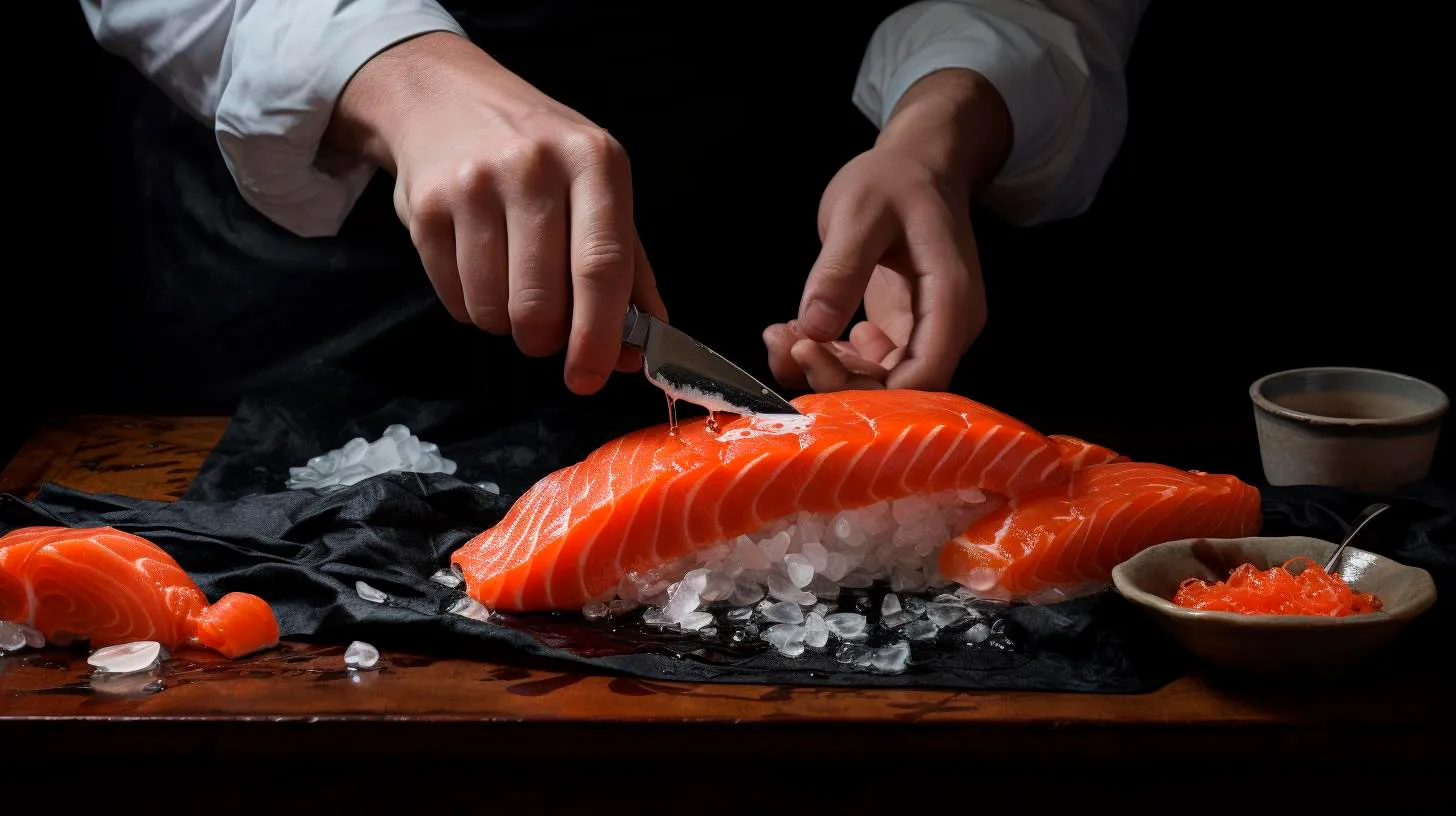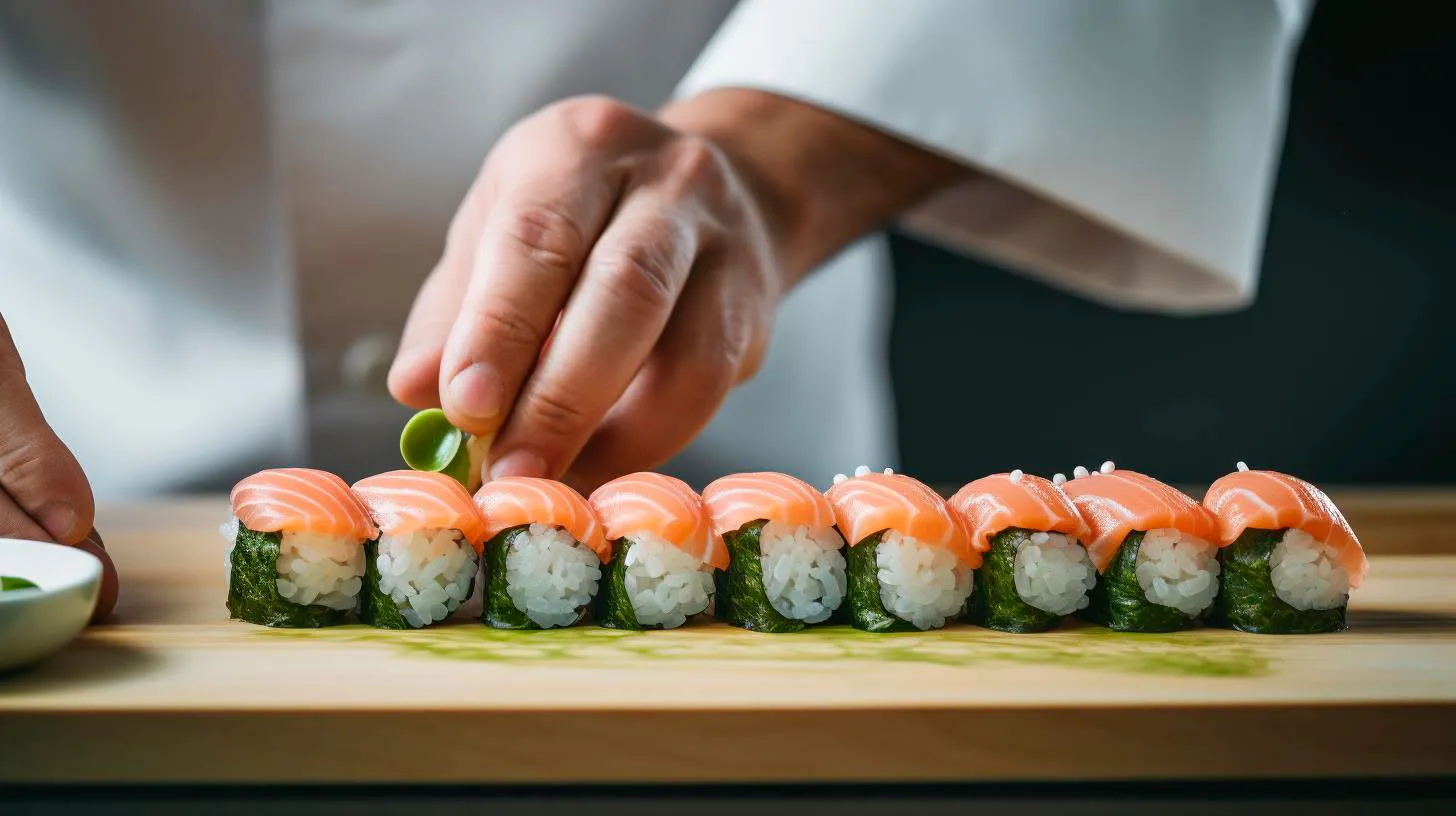Sushi: A Culinary Icon in Samurai Cuisine
In this article, we dive into the rich history of sushi, explore its various types, and highlight the key reasons behind its immense popularity.
A Brief History
Sushi, as we know it today, has evolved over centuries and has its roots in ancient Japan. The earliest form of sushi can be traced back to the 4th century AD, where fish was fermented with rice. However, it was during the Edo period (1603-1868) that sushi started taking its recognizable form. The Edo era marked a significant shift towards the use of vinegar-infused rice, transforming sushi into the delectable dish we savor today.
Types of Sushi
Sushi encompasses a wide variety of forms, each with its unique ingredients and preparation methods. Some popular types of sushi include:
- Nigiri: Nigiri sushi consists of a small mound of vinegared rice topped with a slice of fresh fish or seafood. It is a classic style of sushi that allows the flavors of the fish to shine.
- Maki: Maki sushi features a combination of fish, vegetables, and rice wrapped in seaweed (nori) and then sliced into bite-sized rolls. It is one of the most recognizable types of sushi worldwide.
- Sashimi: While not technically sushi, sashimi is a dish consisting of thinly sliced raw fish or seafood served without rice. It is often enjoyed as an appetizer or paired with sushi.
- Temaki: Temaki sushi is a hand-rolled cone-shaped sushi, where the filling is wrapped in a sheet of nori. It is a popular choice for those who prefer a more casual sushi-eating experience.
Why Sushi is So Popular
Sushi’s popularity has soared in recent years, and for good reason. Here are some key factors contributing to its widespread acclaim:
Health Benefits
Sushi is often praised for its health benefits. Here are a few reasons why:
- Low in Calories: Sushi tends to be low in calories, especially when compared to other international cuisines. It is an excellent choice for those looking to indulge without compromising their health goals.
- Rich in Omega-3 Fatty Acids: Many types of fish used in sushi, such as salmon and tuna, are packed with omega-3 fatty acids that are beneficial for heart health.
- Nutrient-Dense: Sushi often incorporates nutrient-rich ingredients like seaweed, vegetables, and fish, providing a variety of vitamins and minerals.
Culinary Artistry and Presentation
Sushi is not just a dish; it is an art form. Skilled sushi chefs meticulously prepare each piece with utmost precision and attention to detail. The presentation of sushi is as much a treat for the eyes as it is for the taste buds. Here are some reasons why sushi is celebrated for its artistry:
- Aesthetic Appeal: The vibrant colors, intricate arrangements, and beautiful garnishes make sushi a visually appealing dish.
- Precision and Skill: Crafting perfect nigiri or creating intricate sushi rolls requires years of practice and expertise. The dedication of sushi chefs is reflected in each plate served.
- Seasonality: Sushi often incorporates seasonal ingredients, reflecting the culinary diversity of Japan and providing an ever-changing experience for the customers.
Social and Cultural Experience
Aside from its culinary merits, sushi also offers a unique social and cultural experience. Here are a few reasons why sushi has become synonymous with social gatherings and celebrations:
- Sushi Bars and Omakase: Sushi bars and omakase dining experiences allow customers to interact with the chef directly, fostering a personal connection and enhancing the dining experience.
- Shared Plates: Sushi is often enjoyed in a communal setting, promoting social interaction and creating a bonding experience among friends and family.
- Tradition and Rituals: Sushi dining is steeped in tradition and follows certain rituals, such as using chopsticks and appreciating the artistry before indulging.
Key Takeaways
Sushi has rightfully claimed its place as a culinary icon, captivating taste buds worldwide. From its humble origins to its modern-day popularity, sushi continues to evolve while staying true to its traditional roots. Remember these key takeaways:
- Sushi has a rich history dating back centuries and has evolved over time.
- There are various types of sushi, including nigiri, maki, sashimi, and temaki.
- Factors contributing to sushi’s popularity include its health benefits, culinary artistry, and social experience.
- Sushi offers a unique combination of flavors, presentation, and cultural significance.
Delving into the world of sushi is not just about enjoying a delicious meal; it is about immersing yourself in a culinary journey that celebrates tradition, artistry, and shared experiences!
From Samurais to Sushi: The Unbreakable Bond of Tradition
In this article, we will explore the fascinating connection between two iconic elements of Japanese culture: samurais and sushi.
The Legacy of the Samurai
Samurais, the legendary warriors of Japan, played a crucial role in shaping the nation’s history. With their code of honor, bushido, they embodied discipline, loyalty, and a tireless devotion to their craft. These warriors defended their lords and fought with unwavering determination, leaving an indelible mark on Japanese society.
Although the samurai era has long passed, its influence can still be felt today. Here are some key takeaways from the legacy of the samurai:
- Discipline: The samurai’s commitment to discipline is reflected in modern Japanese society. It shapes the work ethic, punctuality, and attention to detail that have become ingrained in the Japanese way of life.
- Honor: The pursuit of honor and integrity, core principles of bushido, are still highly valued in Japanese culture today. Whether in business, sports, or personal relationships, the importance of maintaining one’s honor remains deeply ingrained.
- Bushido’s Influence: The principles of bushido continue to shape various aspects of Japanese culture, including martial arts, literature, and even the way people interact with each other.
The Rise of Sushi
While samurais may have laid the foundation for a strong cultural identity, another aspect of Japanese tradition has successfully captured the hearts and taste buds of millions around the world: sushi. Sushi has evolved from a humble street food to a globally recognized delicacy, maintaining its deep-rooted connection to Japanese heritage.
Here are some reasons behind the rise of sushi:
- Health Benefits: Sushi is known for its nutritional value, thanks to its fresh ingredients, high-quality fish, and low-calorie content. This healthy aspect of sushi has contributed to its popularity in health-conscious societies.
- Artistry and Presentation: Japanese cuisine, including sushi, is known for its meticulous preparation and beautiful presentation. The artistic approach of sushi chefs elevates it from mere food to an aesthetically pleasing culinary experience.
- Global Availability: With the expansion of globalization, sushi is now readily available in many countries. Its popularity has soared as people around the world have embraced its unique flavors and textures.
The Fusion of Tradition and Innovation
The beauty of the Japanese culture lies in its ability to preserve tradition while embracing the modern world. This balance can be seen in the way samurais and sushi have been seamlessly integrated into contemporary society.
Samurais in Modern Japan
Although the samurai way of life has changed, their spirit lives on. Modern Japan has preserved the legacy of samurais through various channels:
- Traditional martial arts such as kendo and aikido continue to be widely practiced, honoring the techniques and values passed down by the samurais.
- The concept of loyalty and honor remains deeply rooted, as seen in the respectful relationships between employers and employees.
- The popularity of samurai-inspired movies, anime, and manga keeps the fascination for these historical figures alive among younger generations.
Sushi Innovation and Beyond
While sushi maintains its authenticity, it has also evolved to cater to a wider audience. New variations and creative twists on traditional sushi have emerged, appealing to different tastes and preferences:
- Fusion sushi, where traditional Japanese ingredients are combined with flavors from other cuisines, has gained popularity both in Japan and internationally.
- Sushi-making classes and workshops have become popular tourist attractions, providing a hands-on experience to visitors interested in learning this art form.
- Technological advancements have also impacted sushi preparation, with automated sushi machines and conveyor belt sushi restaurants becoming increasingly common.
As we delve into the depths of Japanese culture, it becomes apparent that tradition and innovation go hand in hand. From the honorable samurais who protected their land to the artistry and global appeal of sushi, Japan’s legacy continues to inspire and captivate people around the world. It is this unbreakable bond between tradition and progress that makes Japan a truly remarkable country.
Unveiling the Legacy: Sushi’s Indispensable Role in Samurai Culture
Sushi, with its roots in the Samurai era, has played an indispensable role in Japanese society for centuries. In this article, we delve into the captivating saga of sushi and uncover its deep ties to Samurai culture.
The Origins of Sushi
Sushi, in its earliest form, emerged in Southeast Asia as a means of preserving fish by fermenting it with rice and salt. This technique gradually made its way to Japan around the 8th century. However, it wasn’t until the 16th century that sushi underwent a significant transformation, thanks to the influence of Samurai warriors.
Key Takeaway: The history of sushi dates back centuries and has evolved with cultural influences.
Sushi and the Samurai
During the Edo period (1603-1868) in Japan, sushi became a prevalent dish among Samurai warriors. The Samurai valued quick, nutritious meals that provided them with the energy and focus required for battle. The portability and nutritional value of sushi made it an ideal choice for these warriors on the go.
Interestingly, the Samurai influenced the development of sushi in two distinct ways:
- Nigiri Sushi: In contrast to its fermented form, the Samurai preferred sushi made with fresh fish. This preference led to the creation of nigiri sushi, where a slice of raw fish is placed on a small mound of seasoned rice.
- Edomae Sushi: As travel among Samurai warriors increased, the demand for sushi also grew. To cater to this demand, the Edomae style of sushi emerged. Edomae sushi refers to the use of fish caught in Tokyo Bay, which was conveniently located near Edo (modern-day Tokyo). This technique reduced the fermentation time, enabling sushi to be served fresh and delicious.
Key Takeaway: The Samurai’s preference for fresh fish led to the creation of nigiri sushi and the development of the Edomae style.
The Cultural Significance of Sushi
Sushi not only satisfied the dietary needs of the Samurai but also played a significant role in various aspects of their culture. Here are some notable examples:
- Mental Discipline: The art of sushi-making requires precision and meticulousness. Samurai warriors appreciated this attention to detail, which reflected their own commitment to discipline and focus. They saw sushi-making as a way to cultivate and enhance mental discipline.
- Unity: Sushi’s communal aspect made it an ideal dish for Samurai gatherings and celebrations. Sharing a platter of sushi symbolized unity and camaraderie among warriors, fostering a sense of loyalty and solidarity.
- Symbolism: Sushi’s presentation went beyond taste and aesthetics. The combination of ingredients, colors, and textures often held symbolic meanings. For example, red fish represented power and vitality, while white fish symbolized purity and strength.
- Status: Sushi’s association with the Samurai elevated its status in Japanese society. In fact, during the Edo period, consuming sushi was a privilege reserved for the privileged, including the Samurai class.
Key Takeaway: Sushi’s cultural significance extends beyond its nutritional value, playing a pivotal role in Samurai society.
The Samurai-Sushi Legacy Today
Although the Samurai era has long passed, its influence on sushi remains ingrained in contemporary Japanese culture. Sushi has transcended societal boundaries and become a global phenomenon. Today, you can find sushi restaurants in almost every corner of the globe, showcasing its timeless allure and culinary artistry.
Key Takeaway: Sushi continues to captivate people worldwide, carrying the legacy of the Samurai warriors.
Conclusion
Unveiling the legacy of sushi reveals its deep-rooted role in Samurai culture. From its origins in Southeast Asia to the evolution influenced by Samurai warriors, sushi has been cherished for centuries. The cultural significance, symbolism, and culinary artistry associated with sushi continue to inspire awe and appreciation worldwide. So, the next time you savor a piece of nigiri sushi, remember the indelible mark it has left on human history and its vital place in the hearts of Samurai warriors.
A Taste of Tradition: Samurai Love for Sushi
Samurais, the legendary warriors of Japan, not only contributed to the country’s military history but also played a surprising role in shaping the sushi we know today. Let’s delve into the enchanting world of sushi and discover the fascinating connection between samurais and its evolution.
The Legacy of Sushi and Its Samurai Connection
Sushi dates back to the 8th century, where it originated as a way to preserve fish. During that time, fish was stored in fermented rice to aid its preservation. Over the centuries, sushi continued to evolve, incorporating new flavors, styles, and techniques.
It was during the Edo period (1603-1868) that the samurais played an unexpected role in shaping sushi’s destiny. Samurai warriors had strict dietary rules, and sushi aligned perfectly with their needs. The method of consuming raw fish and rice – known as “Edomae sushi” – became the focus of sushi chefs, as they strived to create elegant and visually appealing dishes to satisfy the samurais’ refined tastes.
The makings of Edomae Sushi
Edomae sushi takes its name from the Edo period, where Tokyo was once known as Edo. The tradition of Edomae sushi revolves around using fresh, seasonal ingredients caught in the surrounding waters of Tokyo Bay. Here are some key elements that make Edomae sushi unique:
- Meticulous Selection: Top-quality fish is carefully selected, with the chef’s expertise ensuring that only the freshest and most flavorsome fish make it onto the plate.
- Vinegar Rice: The rice used in Edomae sushi is seasoned with vinegar, sugar, and salt. This delicately balances the flavors of the fish.
- Simple yet Complex: Edomae sushi focuses on simplicity, allowing the natural flavors of the fish to shine. Each sushi piece is meticulously crafted with precise cuts and perfect rice-to-fish ratios.
- Minimal Ingredients: The use of minimal ingredients highlights the quality and freshness of the fish, elevating the dining experience.
Modern Sushi: A Blend of Tradition and Innovation
As sushi gained popularity worldwide, it underwent a transformation to cater to diverse palates and cultures. While traditional sushi is still revered, modern sushi has embraced fusion and experimentation, offering an array of options for sushi lovers. Here are a few key takeaways:
- Global Influences: Sushi has transcended cultural boundaries, leading to the fusion of flavors and techniques from various cuisines. This has given rise to creative sushi rolls like the California roll and spicy tuna roll, among others.
- Health Benefits: Sushi is not only a delightful culinary experience but also offers health benefits. It is low in fat, high in protein and essential nutrients, and rich in omega-3 fatty acids, which promote heart health.
- Artistic Presentation: Sushi has become synonymous with artistry, as chefs create visually stunning dishes that are a treat for both the eyes and the taste buds.
- Sustainability: With growing environmental concerns, the sushi industry is increasingly focusing on sustainable fishing practices and responsible sourcing of ingredients to ensure the preservation of marine ecosystems.
Intriguingly, the ongoing passion for sushi has expanded beyond the boundaries of Japan, becoming a global symbol of culinary excellence. The blend of tradition and innovation has allowed sushi to continually reinvent itself while preserving its cultural heritage.
Conclusion
Samurais and their refined taste for Edomae sushi played a remarkable role in the culinary journey that sushi embarked upon. Today, sushi serves as an ambassador of Japanese culture, captivating food enthusiasts with its rich history, exquisite flavors, and artistic presentation.
So, the next time you savor a delectable piece of sushi, take a moment to appreciate the centuries of tradition, the influence of samurais, and the culinary craftsmanship that goes into each bite. Let sushi transport you to an era when honor, precision, and artistry reigned supreme.


